JARS v45n4 - In the Steps of Kingdon-Ward Through Muli
In the Steps of Kingdon-Ward Through Muli
Warren Berg
Port Ludlow, Washington
Frank Kingdon-Ward made a total of three trips to the kingdom of Muli, two before World War I and his last in 1921-22. Joseph Rock also explored Muli, but it was the writing of Ward that most inspired me to search for rhododendrons in this 9,000-square-mile area. It lies in the southwest corner of the province of Sichuan, China, bordering Tibet on the west and Yunnan on the south. It is such a large and wild region that there are many incredibly huge and difficult mountains that remain untrodden by the plant hunter. Thus, there is always the hope of finding something new or different. Ward said there are "not less than 50 rhododendron species on the Muli ranges." We found perhaps 30 that we could identify, and several more that we couldn't.
This was my sixth exploration to China and tenth to Asia. The group, all from the Seattle area, consisted of Garratt Richardson, M.D., Bill Stipe, manager of Meerkerk Gardens, Dr. Paul Christensen, D.D.S., my oldest son, Tom Berg, landscaper and June Sinclair, rhododendron nut. I would also have to place myself in this last category. Tom and Paul were first timers, but I think they would agree that though it was a rough trip, there were many rewards, which I will try to tell you about.
Up to New Muli
We arrived in Chengdu, the capitol of Sichuan, by air on May 22, 1991, and were met at the airport by a host of Chinese, with lots of flair and picture taking. By the time we reached the hotel it was late and we were hot and tired. After a cold beer we hit the sack, planning an early start the following day. Needless to say, it was noon before everything was organized and ready to go. We departed by "Land Cruiser" on what was, as I had expected, the worst part of the trip. It took four, 8- to 12-hour days of driving to reach our first camp, on roads you have to see to believe. Although the weather was pretty good for most of the trip, it was hotter than I thought it would be, especially at elevations below 8,000 feet. There were numerous mountain ranges to cross, from 10,000 to 15,000 feet, where we could cool off and also check out the rhododendrons. After the second day we entered the zone normally forbidden to foreigners. As a result, whenever we stopped in a village we were mobbed by the local people, most of whom had never seen the likes of us. These people are not Chinese, but ancient tribes with their own languages. Some even have their own script.
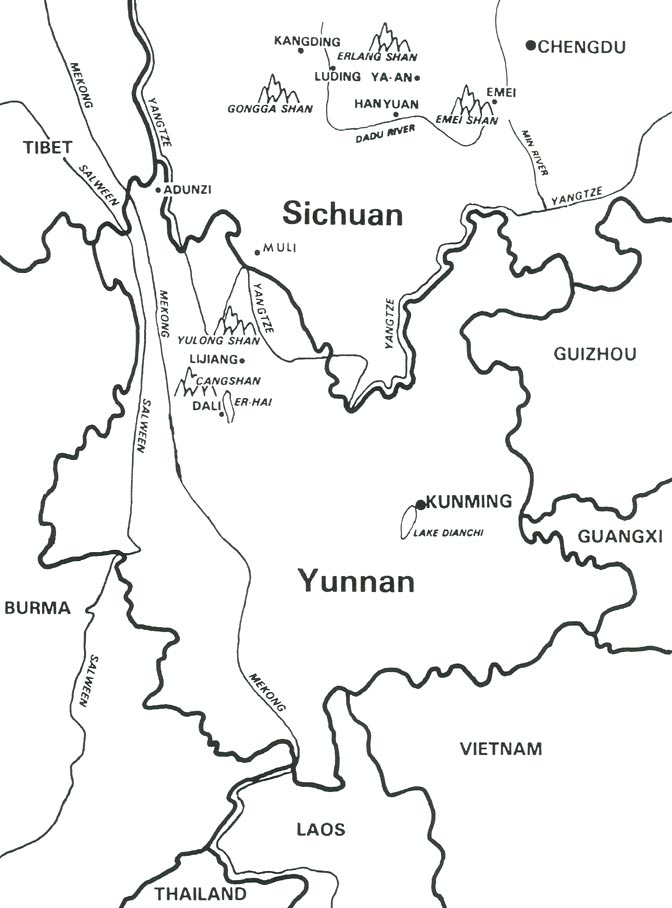
|
| Southwest Sichuan and neighboring provinces of China and Tibet. |
I probably should explain at this point that there is an old and a new Muli. When the Chinese took over the old kingdom of Muli in 1954, they rebuilt and renamed the village of Muli. This walled village and monastery was where the king lived one third of the time. He, accompanied by his whole household, would move annually, spending a year at each of three principal monasteries in turn. These were Muli, Wachin, and Kong. They were situated within two days' journey of each other in the center of the king's dominions. The reason given for this annual exodus is that it gave him better control of the government. New Muli is much larger than old Muli and is a ten-hour drive to the east. It is what we would call the county seat and lies at an elevation of about 7,500 feet. We spent our third night in new Muli and after a terrible nights sleep with the noise of trucks, dogs, and roosters, headed north into a high area called Kong Wu.

|
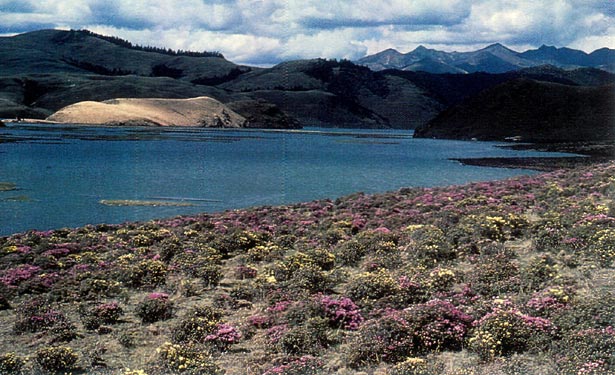
|
|
|
R. rupicola
var.
muliense
and
R. impeditum
,
Kong Wu range, 11,000 feet. Photo by Warren Berg |
Kong Wu Lake and the "Lapponicum Sea"
(at least five different species), 11,000 feet. Photo by Warren Berg |
Kong Wu
As we climbed above 8,500 feet, rhododendrons began to appear in ever increasing numbers and varieties including our old friends R. decorum and R. yunnanense , then R. racemosum along with some Triflora. Near 11,000 feet, we saw R. phaeochrysum , and some of the Lapponica subsection, as well as various plants we were unable to identify. It is, as you can understand, difficult to recognize many of the plants from a moving jeep and impossible to stop every time one sees some color. Our destination after a fairly long, dusty day turned out to be a very beautiful large lake, with floating islands. Some of the islands even had R. impeditum growing on them. This lake of Kong Wu was in a high valley at about 11,500 feet. The shoreline and surrounding hillside were a mass of color, composed of solid thickets of many different purplish blue Lapponica, mostly R. impeditum mixed with large patches of the golden R. rupicola var. muliense , an elegant little plant. This is very close to R. chryseum , but a deeper yellow. Some of the others were R. intricatum , R. primuliflorum and a very rare apricot form of R. orthocladum var. longistylum , which I had never seen before. It was easy to see why Kingdon-Ward described this as the "Lapponicum Sea, with colors forming a chromatic foam tossing on the surface."

|

|
|
|
Deep pink
R. phaeochrysum
var.
agglutinatum
,
Muli range, 13,000 feet. Photo by Warren Berg |
R. orthocladum
,
Kong Wu range, 11,000 feet, rare color form. Photo by Warren Berg |
We set up our tents near the lake shore and after a half way decent dinner, built a campfire, sat back and enjoyed the view as the sun went over the scenic mountains to the west. Having planned a rigorous following day, we were early to bed and early to rise. With a rather meager, unappetizing breakfast (helps to get rid of a few un-needed pounds), we were on our way to a nearby ridge. Luckily, we found an old yak trail which, as we approached the top, led us through thickets of R. phaeochrysum var. agglutinatum and var. levistratum . They seemed to grow on most of the high ridges above 11,000 feet. As we crossed over to the other side, we found some very fine large R. vernicosum , mostly white, but also a few choice rose colored ones, speckled inside with crimson markings. It was a little more wooded on this side, but in some of the open spots were natural rock gardens with various wild flowers including Incarviilea mairei and both the purple ( purplerea ) and rare yellow ( cautiloides ) form of Roscoea . These flowers were particularly graceful, delicate and alluring in color. To our great surprise, in the far valley about 1,500 feet below, were the remains of the old village and monastery of Kong (this was one of the former king's residences that I mentioned earlier). We decided it would be well worth the effort to go down for photos and whatever else was to be found. There were lots of rhododendrons on the way down and the ruins proved most interesting. Nearby was a large circular pyramid of rock slabs engraved with the sacred prayer, Om mani padme hum . This may be translated: "The Jewel in the Heart of the Lotus." These were usually carved by the lama monks and are called "Mani Piles."
It was a hot climb back up, but we were able to avoid the heavy brush, having found a very good trail that was probably used by the king and his people to cross over to our lake. Half way up, where it was cooler, we found the remains of a large estate-type building which I think may have been the king's hot weather retreat. All in all it was a very rewarding day, except for the warm beer on our return to camp (better than no beer, however).

|
|
View of Minya Konka range on return from Muli.
Photo by Warren Berg |
Ssu-ho
We left early the following morning for a place called Ssu-ho, which is on the Litang River, about three hours' drive north of old Muli. The routing was like a big horseshoe, taking us through the city of Wachin. This was the location of the third monastery where the king lived, but we were unable to locate it.
Ssu-ho is a fairly small logging village populated by people of the Zong minority. It is on the east slope of the Muli range, which runs north and south for at least 100 miles and is perhaps 30 to 60 miles from east to west. It reminds me of the Olympic range here in Washington. Extending up from the village is a very rough, steep logging road with a fork about half way up. Both roads reach the top, about 20 miles apart, so we spent a day in each area. It was a two-hour drive each way from 7,500 feet to 13,000 feet. The first day on top was spent exploring to the south towards Mount Mitzuga, which is just west and in back of old Muli. There were lots of blooming R. phaeochrysum , some up to 25 feet high. In the open meadows were large clumps of various Lapponica, including a few R. muliense just breaking bud, with a scattering of a brilliant yellow Meconopsis integrifolia . At the very top of the ridge were large, natural rock gardens meshed with flowers nestling in pockets or forming drifts of color over the rock. Some of the slopes were splattered with a dense mat of scrub oak. The most exciting find were several creamy white and light yellow R. sargentianum and a very few light rose R. trichostomum . Here at 13,000 feet the view was something else. Far to the west, just peaking below the clouds, were the three sacred 20,000-foot snow peaks of the Konkaling range. Rock called these the "Mountains of the Outlaws," as they were inhabited by Tibetan outlaws.
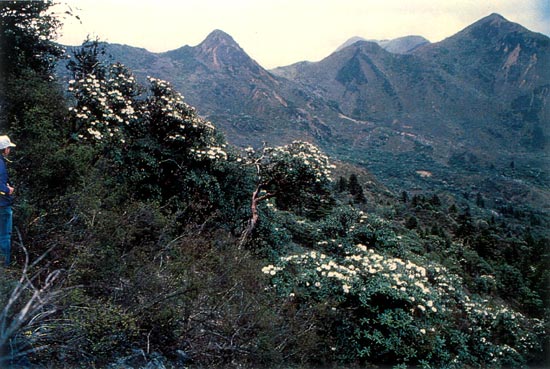
|
|
Muli range with
R. phaeochrysum
and Paul Christensen, 14,000 feet.
Photo by Warren Berg |
The only sign of life on these high ridges, besides a small bunch of skittish Dzo (these are yak hybrids), was a very clever rabbit trap set so that a boulder would fall on the unsuspecting rabbit when tripped. As we drove down the mountain on our return, we would stop now and then to check out the different rhododendrons which vary quite a lot with elevation. At about 12,000 feet we found one of the best deep yellow R. wardii that I have ever seen. Farther down were several different Triflora and an occasional R. vernicosum .
The next day we took the north fork of the same road, which wound through a logging area. When we reached the top, we headed in the opposite direction of the previous day hoping to find something different. After about two hours, and nothing new, we started hiking down. In a very short distance, we lucked out by finding some R. beesianum in bloom, growing amongst the fir and birch. Later we saw more of it in the logged off areas, apparently having survived the logging operation. It does prefer the company and protection of the conifers however (so did we in the hot weather).
As we descended to 10,000 feet, we found several different Triflora in the last stages of bloom. These included, R. tatsienense , R. davidsonianum , R. oreotrephes , and of course lots of R. yunnanense . There were also some very nice deep pink R. cephalanthum and the ever present R. decorum .
Old Muli
Leaving Ssu-ho, we followed the Litang River south about 25 miles to where the Muli River entered the Litang, and then turned west up the river to our final destination, the village of old Muli. The elevation here is 8,500 feet, thus a little cooler than Ssu-ho.
The first view of Muli was quite a thrill, at least for me, having spent so much time and effort getting there. It looked very much as I had pictured it from Rock's photo in the old July 1931 National Geographic, except most of the buildings had been replaced and there was not much left of the old wall. The only street was dirt, about two blocks long, with dogs, pigs of all sizes, and kids running every which way. It is not much to brag about, but the people were very friendly and interesting. Our arrival happened to coincide with the annual children's day so there were lots of people in town in their best colorful dress. Needless to say, we created quite a sensation as we entered town. Fortunately, an English speaking teacher befriended us and after lots of questions back and forth, invited us to a performance at the school. Everything came to a halt upon our entrance, but after the kids all settled down, we were given front row seats up on the stage and they continued the program. It was here that a radio message reached us that June's husband was seriously ill. Within 30 minutes, she was packed and left with one of the Jeeps. This of course put a damper on things, because the best part of the trip was yet to come.
Before I continue on the rest of this venture, let me paraphrase from Kingdon-Ward to give you an idea of the overnight accommodations in rural China.
The Inn of Golden Happiness
"Lest the optimistic traveler believes he is going to find a snug hostelry waiting for him at the end of the day's march, I hasten to reassure him. There is nothing so prosaic. Native inns in western China are the last thing in dirt and discomfort." (The comfort of the inn varies inversely to the size of the city, and the comfort of a guest house is in direct proportion to the size of a village - Berg's law). "The room is usually about 10 feet square, and dismally dark, despite the fact that the paper window is in tatters. The walls are black with smoke, dirt, and cobwebs; the floor boards undulate like a choppy sea, sometimes they rise up and smite you, when stepped on. The fixtures include ticks, fleas, bugs, spiders, and other athletic and voracious insects. If there is furniture, it is filthy with rancid vegetable oil and the bed consists of some boards laid across a couple of trestles, sometimes covered with a dirty straw pallet infested with bed bugs. If this weren't enough, the dynamic smells drifting from the village outhouse seem to permeate every inn where distinguished foreigners must stay. And of course there is no such thing as privacy." I have taken the trouble to explain the above, so the reader will understand why we much prefer to reside in our own tents, away from villages.
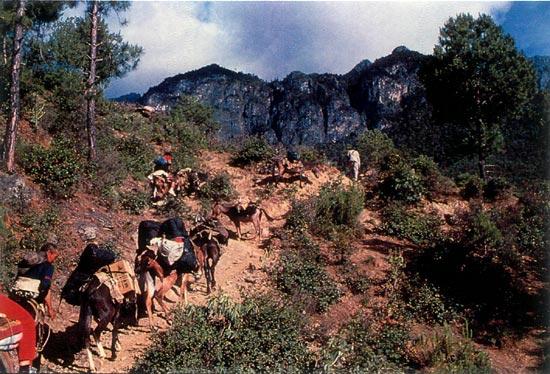
|
|
Mule pack train out of Old Muli, climbing to 12,000 feet.
Photo by Warren Berg |
There were 19 horses and mules lined up for our departure the following morning, far more than necessary for four days and our group of eight, which included the local guide Mr. Pian Chu, Chinese trip leader Mr. Qiao and interpreter Miss Huang. This was the dry season, and a few of the animals were a bit thin and moth-eaten, so I guess its better to use three mules to carry a load safely than to employ two and have them fall over a cliff (they never do it when you happen to be looking and unfortunately are rarely able to repeat the performance). Normally the start is late, but in this case, the muleteers were right on time. They were of the Nachi tribe, having come up from 50 miles south in Yunnan. The loads are lashed one on either side of a wooden pack frame with such a mess of bends and hitches that you feel they never can be undone (unless they try to pass on a narrow trail or bang against a tree). Unfortunately, they also use this same sharp pointed rack on the riding mules. The muleteers never seemed to figure out why we sat so far aft when we rode. Of course it was more comfortable, but it was also easier to exit in case of a low overhang.
Our camp was 12 miles up on the Muli range at an elevation of 12,000 feet. It took six hours and lots of bloodcurdling threats directed at the mules to get there. Just as we started setting up the tents, it started to rain, the first real rain of the trip.
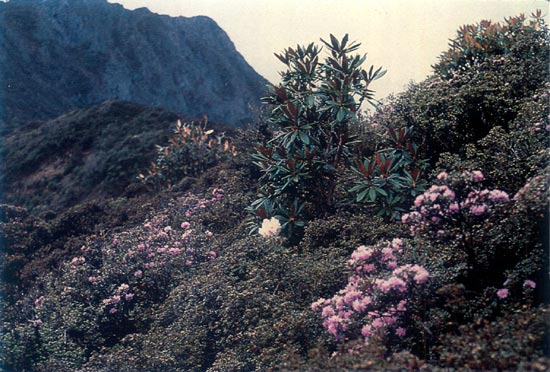
|
|
R. intricatum
,
R. phaeochrysum
and
R. roxieanum
var.
cucullatum
,
Muli range, 14,000 feet. Photo by Warren Berg |
The next morning the five of us elected to climb south to the crest of the divide. It was here we found one of the very special rhododendrons that we were looking for. R. roxieanum var. cucullatum . Bill spotted the first one growing amongst a hillside of Lapponica. I figured if there were one here, there should be more on the other side. Sure enough, after crossing the top at 14,000 feet, the entire west side was covered with them as far as could be seen. The bloom was pretty much over, but there were enough late flowers to get some pictures. The color was mostly white, with a few pinks scattered about. There were many of the previously mentioned rhododendrons here as well. Bill and Tom found what I am sure was R. clementinae , but they managed to lose the sample, somewhere in the brush, on the way back to camp.
The following day we decided to go west of camp, again climbing to a 14,000-foot ridge. In Muli country the timber line extends to 15,500 feet. Fir, spruce, and larch are found up to 15,000 feet, while for the remaining 500 feet, vast rhododendron forests composed of trees to 25 feet in height cover the spurs and ridges. The mountains are limestone, often with large outcroppings of slate. There were pretty much the same species on the way up, except for R. beesianum. At the top was a profusion of wild flowers, including several primulas, iris, anemones, and unknown species, forming a veritable carpet of exquisite color.
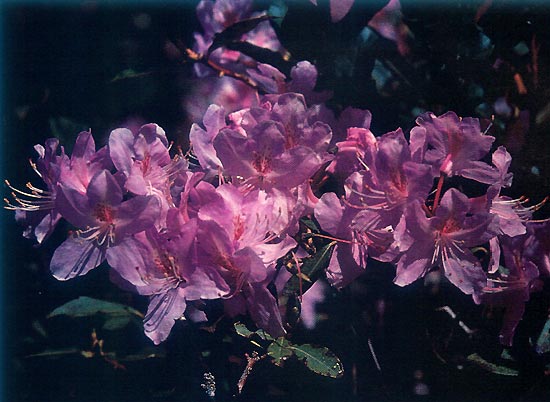
|
|
Deep clear pink form of
R. yunnanense
, Muli range, 10,200 feet.
Photo by Warren Berg |
Garratt, Paul and I spent a leisurely afternoon taking pictures and exploring along the ridge, while Bill and Tom went down the back side to a small lake some distance below. It was here that we had a problem that we all can learn from. I have always requested that we should use the buddy system and plan to be back in camp by five p.m. Somehow Bill and Tom got separated. When Bill started back, he unknowingly went down the wrong ridge, heading west instead of east. Several miles and over 2,000 feet later, he came to what should have been our camp river, only it was flowing in the wrong direction. Realizing he was lost, he forced himself to remain calm, knowing he would have to climb all the way back to the 14,000-foot ridge where he had last seen the lake. This he did and upon finding an arrow scratched in the trail, which I always leave before starting down, he knew he had found the correct trail. He got back to camp just before dark, completely exhausted after almost 30 miles of hiking.
The next day we broke camp, got the mules rounded up, and headed back to old Muli. It took seven days from here to get back to Seattle. Rock or Ward would have thought that was pretty fast, but I thought it was too much time lost on a 23-day trip, besides being very tiring and dangerous. Our departure was timed pretty well, as the seasonal rains started our last night and there was fresh snow on the mountain tops. Many of the roads were a red clay and very slippery.
While still in the restricted area, we spent a night in a city where a tribal festival dance was being held. We were all pretty tired, but Garratt and I decided to go for a short time. This turned out to be very interesting, and I managed to get a few flash photos of the dancers in their colorful native dress. (We managed to be less tired when a couple of the pretty native girls wanted to practice their English and do the Chinese version of our old fashioned round dance.)
The evening before our departure from Chengdu on June 12, the Sichuan government put on a terrific banquet for us. There were at least 30 courses, beautifully served and very elegant. The state of Washington is a sister state to Sichuan, and our Secretary of State had corresponded with them on our behalf. I think this helped explain the hospitality.
Taking everything into consideration, this was a very successful, undeniably fascinating expedition. I couldn't have asked for a better group to travel with and the Chinese, though lacking experience, tried very hard to meet our requirements. This was particularly true of Mr. Qiao and Mr. Pian Chu, the tall handsome local guide of the Zong minority who always carried a huge knife and a large pistol in his belt. Much of the success of the trip was due to their extra efforts and helpfulness.
Would I return to Muli? Probably not; the transportation problems were too formidable and risky. Besides, maybe I am just getting too old - of course I have said that before.
Warren Berg, an explorer of rhododendron country and a rhododendron hybridizer, is a long-time ARS member and member of the Rhododendron Species Foundation and contributor to the Journal.
